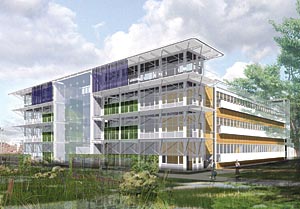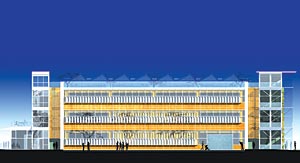An Evolving Edifice That Will Improve With Time
History as inspiration
The CIRS project is not without precedent. One earlier living lab is the Robert L. Preger Intelligent Workplace (IW), built in Pittsburgh at Carnegie Mellon University in 1997. The $4 million facility sits atop an early-20th-century building in a penthouse addition designed by architects Bohlin Cywinski Jackson and Pierre Zoelly [Record, June 1998, page 148].
 |
 |
| The south facade (top) has a catwalk to facilitate the change-out and testing of components such as photovoltaic panels, shading devices, and glazing. The west (above) and east facades will be more fixed, but adaptable. They will have internal and external light shelves as well as adjustable vertical shading fins. |
The IW serves as offices for the Center for Building Performance and Diagnostics (a division of Carnegie Mellon's school of architecture), and as a reconfigurable facility where the effectiveness of new building products and systems are tested and evaluated. In the nine years since its opening, architecture masters and doctoral candidates have used the IW to perform many kinds of investigations, including lighting and daylighting evaluations, ventilation studies, and acoustics research. For the first seven years, the facility relied on the university's infrastructure for power. However, researchers recently began examining the potential of on-site generated renewable energy, and have installed solar thermal collectors on the penthouse roof [see sidebar].
The university hopes to further explore distributed energy systems in a project it has dubbed "building as power plant." It plans an approximately 40,000-square-foot academic building that will be a net energy producer. The 7,000-square-foot IW has "only modest heating and cooling loads and is not big enough to support the next generation of power systems," says Vivian Loftness, FAIA, senior researcher for the Center for Building Performance and Diagnostics and former head of the architecture school. Before building this much larger living lab, Carnegie Mellon will have to conduct a national fund-raising campaign, says Loftness.
More than an experiment
Unlike Carnegie Mellon's IW, the Vancouver facility will include office space for nonacademic tenants. One of these tenants is the region's electric utility, BC Hydro. It has signed a 25-year, prepaid lease for about 8,500 square feet of office space. The funds will be used to help finance construction-a way to reap the rewards of CIRS's promised lower operating costs up front. This practice is atypical for developers, and even for long-term institutional owners, who rarely intermingle capital and operating budgets. "One of the biggest barriers to building sustainably is the operating/development cost split," says Robinson.









